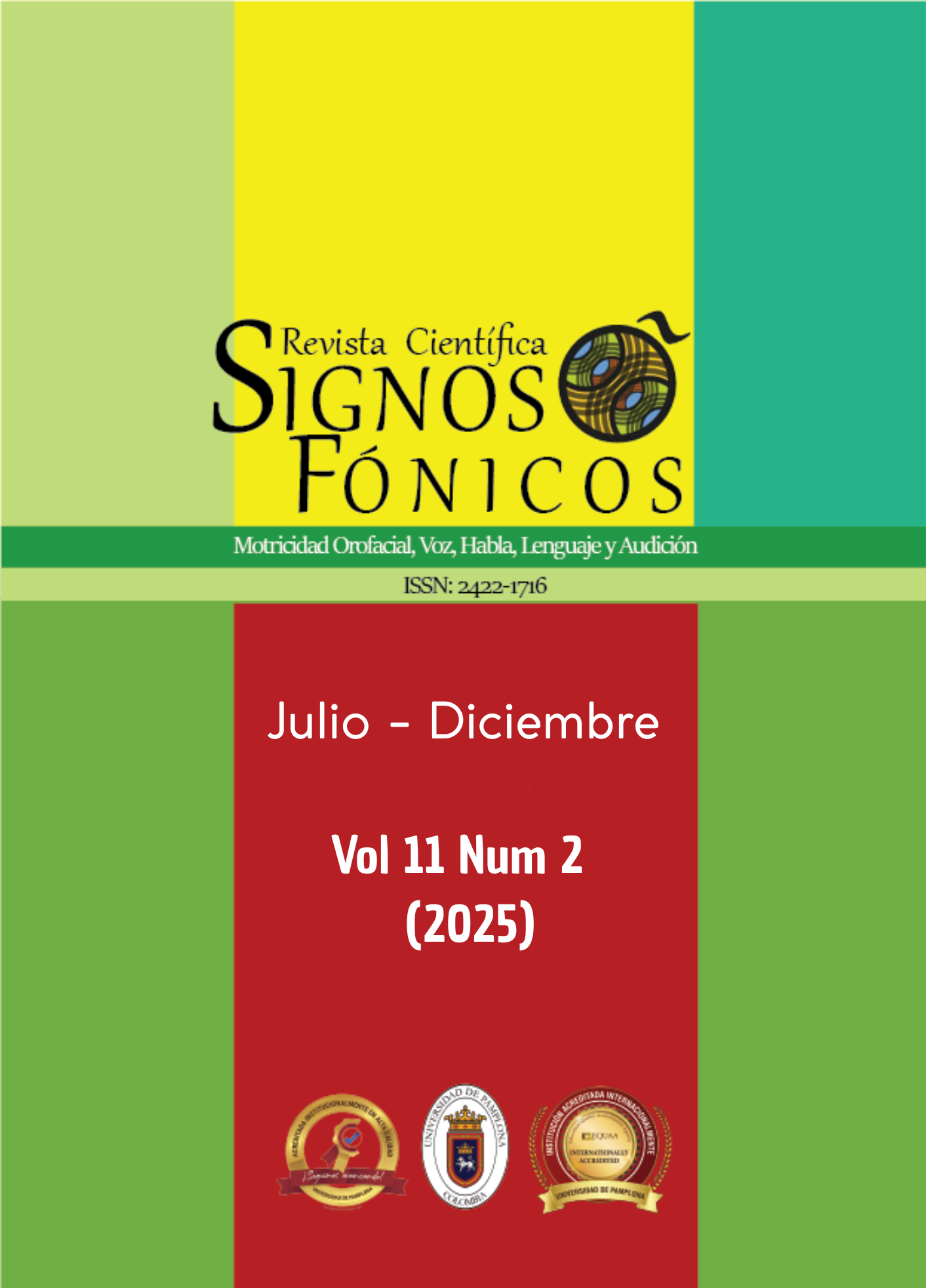Impacto del aislamiento por Covid-19 en el desarrollo del lenguaje: una corte de niños en Cartagena Colombia
DOI:
https://doi.org/10.24054/7096yw85Palabras clave:
Lenguaje, Desarrollo infantil, Aislamiento social, Pandemia de COVID-19, Interacciones madre-hijo, Niños, PadresResumen
El COVID-19 es una enfermedad infecciosa que provocó la implementación de medidas como el aislamiento social en numerosos países, incluido Colombia. Este aislamiento, extendido por aproximadamente 12 meses generó deprivación ambiental en niños en desarrollo al limitar experiencias sociales, de juegos en el entorno. Este estudio tuvo como objetivo valorar el impacto del aislamiento por Covid-19 en el desarrollo del lenguaje de los niños que nacieron durante este período. La metodología se centró en un estudio correlacional de corte transversal en el que se aplicó El Inventario del Desarrollo Comunicativo MacArthur-Bates a padres y/o cuidadores de niños junto a una entrevista sociodemográfica estructurada. En los resultados de la investigación un porcentaje importante mostró un vocabulario expresivo pobre, alteración en la producción de oraciones y afectaciones en el uso de la gramática según lo esperado para su edad. Aunque estadísticamente no hubo significancia estadística relevante en entre los criterios cruzados, factores sociodemográficos como las diferencias de clases, la exposición a la cultura popular cartagenera y la informalidad laboral, fueron aspectos que influyeron en el estudio. Finalmente, se concluye que el aislamiento por COVID-19, generó una serie de implicaciones en el desarrollo del lenguaje de los niños nacidos en este período, pero no es concluyente.
Descargas
Referencias
Aimacaña Toctaguano AG, Del Rocio Tapia Reinoso S, Rumiñahui G. La interacción social en el desarrollo del lenguaje oral en niños de 1-3 años durante la pandemia. Revista Vínculos ESPE [Internet]. 2022 May 1 [cited 2022 Oct 29];7(2):77–90. Available from: https://journal.espe.edu.ec/ojs/index.php/vinculos/article/view/2527
Benner AD, Mistry RS. Child Development During the COVID-19 Pandemic Through a Life Course Theory Lens. Child Dev Perspect [Internet]. 2020 Dec 1 [cited 2022 Oct 29];14(4):236–43. Available from: https://onlinelibrary.wiley.com/doi/full/10.1111/cdep.12387
Busaad Y, Prof A, Alnaim M. Parents’ perceptions regarding the effects of COVID-19 on their children with and without disabilities. International Journal of Instruction [Internet]. 2021 [cited 2024 Apr 28];14(4):997–1012. Available from: https://doi.org/10.29333/iji.2021.14457a
Charney SA, Camarata SM, Chern A. Potential Impact of the COVID-19 Pandemic on Communication and Language Skills in Children. Otolaryngol Head Neck Surg [Internet]. 2021 Jul 1 [cited 2024 Apr 28];165(1):1–2. Available from: https://pubmed.ncbi.nlm.nih.gov/33258739/
Deoni SC, Beauchemin J, Volpe A, D’Sa V, Consortium the R. The COVID-19 Pandemic and Early Child Cognitive Development: A Comparison of Development in Children Born During the Pandemic and Historical References. medRxiv [Internet]. 2022 Aug 16 [cited 2024 Apr 28];2:2021.08.10.21261846. Available from: https://www.medrxiv.org/content/10.1101/2021.08.10.21261846v2
Departamento Administrativo Nacional de Estadística (DANE). Estadísticas Vitales (EEVV). [cited 2025 May 18]; Available from: https://www.dane.gov.co/files/operaciones/EEVV/bol-EEVV-Nacimientos-IIItrim2023.pdf
Farkas C. McArthur’Bates Communicative Development Inventory (CDI): Proposal of an Abbreviate Version. Universitas Psychologica [Internet]. 2011 [cited 2023 May 27];10(1):245–62. Available from: http://www.scielo.org.co/scielo.php?script=sci_arttext&pid=S1657-92672011000100020&lng=en&nrm=iso&tlng=es
Izci B, Geesa RL, Chen S, Song HS. Home Learning Environments During the COVID-19 Pandemic: Caregivers’ and Children’s Perceptions. Journal of Research in Childhood Education [Internet]. 2023 Aug 8 [cited 2024 Apr 28];37(4):493–505. Available from: https://tandfonline.utb.elogim.com/doi/abs/10.1080/02568543.2022.2143459
Kartushina N, Mani N, Aktan-Erciyes A, Alaslani K, Aldrich NJ, Almohammadi A, et al. COVID-19 first lockdown as a window into language acquisition: associations between caregiver-child activities and vocabulary gains. Language Development Research [Internet]. 2022 Feb 6 [cited 2022 Oct 31];2(1):1–36. Available from: http://ldr.lps.library.cmu.edu/article/id/518/
Lara Díaz MF, Gálvez Bohórquez DM, Gómez Fonseca ÁM, Mesa Guechá C, Sellabona ES. Normativización del Inventario del Desarrollo Comunicativo MacArthur-Bates al español, Colombia. Rev Latinoam Psicol [Internet]. 2011 [cited 2022 Oct 30];43(2):241–54. Available from: http://www.scielo.org.co/scielo.php?script=sci_arttext&pid=S0120-05342011000200004&lng=en&nrm=iso&tlng=es
Lankinen V, Lähteenmäki M, Kaljonen A, Korpilahti P. Father–child activities and paternal attitudes in early child language development: the STEPS study. Early Child Dev Care [Internet]. 2020 [cited 2024 Apr 28];190(13):2078–92. Available from: https://tandfonline.utb.elogim.com/doi/abs/10.1080/03004430.2018.1557160
Mathrani A, Sarvesh T, Umer R. Digital divide framework: online learning in developing countries during the COVID-19 lockdown. Globalisation, Societies and Education [Internet]. 2022 Oct 20 [cited 2025 May 18];20(5):625–40. Available from: https://www.tandfonline.com/doi/pdf/10.1080/14767724.2021.1981253
Ministerio de Salud y Protección Social. Coronavirus (COVID-19) [Internet]. [cited 2022 Oct 26]. Available from: https://www.minsalud.gov.co/salud/publica/PET/Paginas/Covid.aspx
Mineducación. Circular No. 09. [cited 2025 May 18]; Available from: http://encuestas.mineducacion.gov.co/limesurvey/index.php/652522?lang=es,
Organización Mundial de la Salud. Coronavirus [Internet]. [cited 2022 Oct 26]. Available from: https://www.who.int/es/health-topics/coronavirus#tab=tab_1
Owens RE. Desarrollo del Lenguaje [Internet]. 5th ed. Pearson Educacion, editor. Pearson Editorial. 2003 [cited 2023 May 8]. 1–484 p. Available from: https://elibro.net/es/ereader/uladech/45301?fs_q=desarrollo__del__lenguaje__oral__&prev=fs&page=284
Quenzer-Alfred C, Schneider L, Soyka V, Harbrecht M, Blume V, Mays D. No nursery ‘til school – the transition to primary school without institutional transition support due to the COVID-19 shutdown in Germany. https://doi.org/101080/0885625720211872850 [Internet]. 2021 [cited 2023 May 27];36(1):127–41. Available from: https://www.tandfonline.com/doi/abs/10.1080/08856257.2021.1872850
Resches M, Querejeta M, Kohan Cortada A, Laguens A. Adaptación y normativización del Inventario del Desarrollo Comunicativo Mac Arthur Bates (CDI-Forma II) al español rioplatense. Revista Iberoamericana de Psicología [Internet]. 2021 Jul 1 [cited 2022 Oct 30];14(3):107–20. Available from: https://reviberopsicologia.ibero.edu.co/article/view/rip.14310
Stamati M, Gago Galvagno LG, Miller SE, Elgier AM, Hauché RA, Azzollini SC. Association between electronic media use, development milestones and language in infants. Interdisciplinaria: Revista de psicología y ciencias afines = journal of psychology and related sciences [Internet]. 2022 [cited 2023 May 27];39(3):151–66. Available from: https://dialnet.unirioja.es/servlet/citart?info=link&codigo=8704791&orden=0
Descargas
Publicado
Número
Sección
Licencia
Derechos de autor 2025 Dominguez Meza AC, Buelvas Vega BV. Impacto del aislamiento por Covid-19 en el desarrollo del lenguaje: una corte de niños en Cartagena Colombia. Revista Científica Signos Fónicos, 2025; 11 (2): 13-24

Esta obra está bajo una licencia internacional Creative Commons Atribución-NoComercial-SinDerivadas 4.0.











